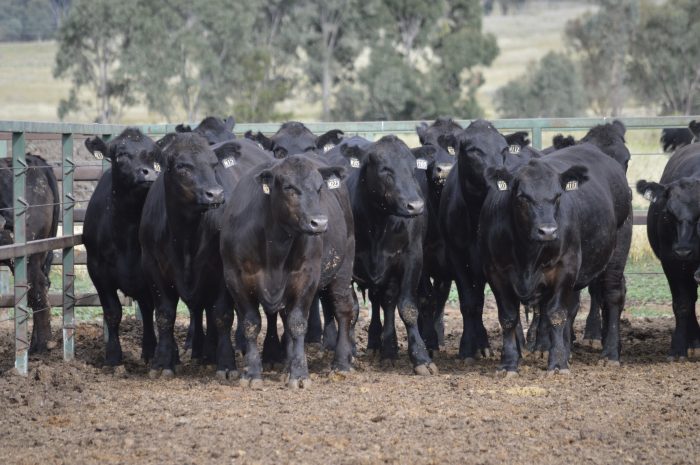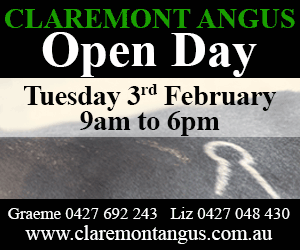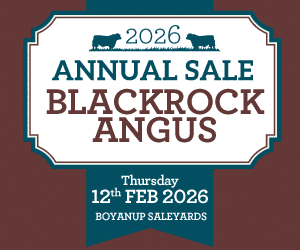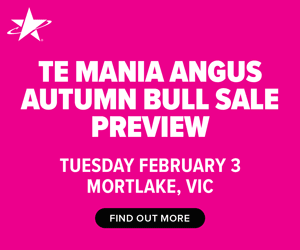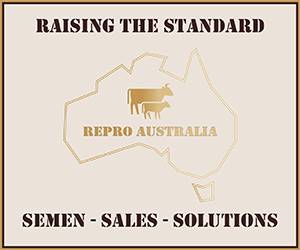The final quarter of the history of Angus Australia has brought forth some important additions to the society, which assisted in establishing it to what it has become today, as Angus Australia has greatly increased its involvement in recent years in research and development (R&D) activities.
The increased involvement in R&D represents a large transition from traditional breed society activities, and is consistent with Angus Australia’s vision of being a member-based, not-for-profit, innovation company servicing seedstock and commercial producers of Angus and Angus-influenced cattle.
The presidents during this time have been R Keith McFarlane (1994-1996), Graham White (1996-1998), John Cochrane (1998-2000), Peter Grieve (2000-2002, 2006-2007), Derek Lotz (2002-2004), Dennis Ginn (2004-2006), John Young (2007-2009), Brian O’Sullivan (2009-2011), Mark Gubbins (2011-2015), Mike Gadd (2013-2015), Hugh M Munro (2015-2016), Libby Creek (2016-2018) and Brad Gilmour (present).
Advancements in technology continue
The last 25 years have seen some major achievements in the space of research and development made for the benefit of Angus producers.
The preliminary findings of the Trangie Efficiency Project, a major initiative by the Trangie Agricultural Research Centre (commenced in 1992) were announced in 1995. The aim of the project investigated Net Feed Conversion Efficiency in beef cattle.
The project was launched following the findings made in previous Trangie research projects, which found the demonstration of large differences in the efficiency of feed conversion of individual cows and calves with similar liveweight and growth rate potential.
Findings from testing showed the number of progeny, average growth weight, 400 day weight, actual feed intake and net feed intake of 15 Angus sire progeny groups. The first trial of EBVs for feed efficiency were published by TACE in early 2002. By 2006, 25,000 Angus animals had reportable net feed intake (NFI) EBVs (Estimated Breeding Values), with the NFI EBVs appearing for the first time on the Angus Group TACE analysis in June 2006.
1995 saw the first Trans-Tasman TACE link, resulting in the much wider Angus GROUP TACE, which introduced the largest group of performance records of any breed in Australia at the time. By the end of the decade, Angus producers also had access to the American Angus Association database through GROUP TACE.
1996 saw the development of the Young Bull Proving Scheme, used to identify the optimal genetics to balance profits for paddock performance and any given market. The scheme utilised the BREEDOBJECT system, a system developed by Animal Genetics and Breeding Unit (AGBU).
The scheme saw all performance traits given a dollar value and the young performance recorded bulls have a selection index calculated, ranking the bulls for their balance of traits impacting commercial profitability. The scheme saws 100 candidate bulls selected annually, structurally assessed with the best 20 targeted for the scheme.
Gene markers for carcase and meat quality were introduced by CSIRO at the BEEFEX Conference in 1996. This was first development in the form of DNA, with the influence of environment, and how it could determine the way in which an animal an animal grows, develops and reproduces, through the identification of different forms of genes.
The introduction of gene markers saw the ability to record difficult and costly to measure traits, such as tenderness, marbling and carcase yield, some of the most important traits for the end product of the animal. Additionally, at this time gene markers were developed for various genetics conditions and diseases, in order to identify these in carriers.
The Angus Commercial Register (ACR) was established with the means to encourage the use of performance recorded stock in commercial herds. The ACR saw commercial producers individually identify all parents and progeny (heifers and steers) in their herds, for the purpose to feed information back into TACE resulting in females having performance predictions to assist in culling decisions. Steers pedigree and EBVS were then passed from producer to feedlot to identify those with the desired carcase and marbling scores.
Meat and Livestock Australia (MLA) introduced the Meat Standards Australia (MSA) grading systems scheme in 1998. This system was introduced after the variable eating quality of meat a leading contributing factor to declining beef consumption in the country. The MSA introduced a system that calculated and differenced meat on three levels of eating quality. This system allowed for the heightened quality Angus product, beginning with the producers, through to the supply chain to the consumer. The model was further expanded in 2005, with the MSA index introduced as a standard national measure of the predicted eating quality of a carcase.
1998 saw the launch of the Angus Australia website, developed by Project Officer Erica Halliday (nee Steel). In 1999 the website incorporated a member search facility, which was followed by the development of animal pedigree and EBV lookup facility.
Rounding out the decade saw figures supporting the further expansion of Angus into commercial herds around the country, with 1999 seeing 8.4% of Australia’s beef herd being Angus, up from 4.2% in 1990, with a further jump to over 10% in the new millennium.
Furthermore, 16% of bulls in the national herd were recorded as Angus, indicating that Angus was being utilised in crossbreeding programs.
The society launched the Commercial Angus Tagging System in 2000 with the purpose to clearly identify Angus cattle bred from Angus Registered Sires. The initiative successfully affected the marketing of Angus cattle, as the tags assisted feedlot purchasers in selecting cattle that we Angus assured.
2002 saw the change from blood typing to DNA testing for parent verification.
The GeneSTAR Marbling Test technology was developed in and released in 2000, allowing Angus breeders access to the first commercial DNA diagnostic test for marbling. The test allowed breeders to test for the trait, and therefore could incorporate its findings into their breeding objectives.
2001 saw EBVs utilised in the judging at the Royal Shows, with Melbourne and Sydney adopting to allow judges to be supplied with the EBVs of an animal, to maintain the relevance of the show to modern day agriculture.
2001 also introduced the Angus Progeny Test Program, a joint venture between MLA and NSW Department of Agriculture, which was adapted to identify and prove out Australian bred Angus sires for use domestically and internationally.
The program invited Angus breeders to nominate bulls for research purposes at Trangie Agricultural Research and Advisory Station. 13 sires were selected in the first test round of the program, with the full calf performance records, feed efficiency and full carcase records collected through the program.
Female calves were retained and joined for reproductive and maternal information and structural assessment records. Performance records generated by the program were submitted into Angus Group TACE. The program was completed in 2006.
Angus Australia also launched the Angus Total Genetic Resource Management (TGRM) technology, which allowed breeders to make accurate mating decisions minimising in-breeding effects for seedstock producers.
The society first started work with structural assessment traits, and following on, the development of EBVs for structure in 2002. While structural scores had been a tool in the industry for some time, it was in 2002 that a number of people received accreditation as scorers and therefore were accredited to submit data into ABRI, thus affecting the TACE data.
The first set of structural scores submitted to TACE were those from cows involved in the Angus Progeny Test Program.
The August 2014 TACE evaluation saw updated Trial Structural Soundness EBVs for individual animals made available to view on the Angus TACE evaluation, with five traits available, being Front Feet Angle, Front Feet Claw Set, Rear Feet Angle, Rear Led Hind View and Rear Leg Side View.
In 2003 regulations were introduced that called on DNA requirements on Herd Book Registered (HBR) animals. These registrations were the first of their kind for the society and were introduced to assist in enhancing the Australian Angus national herd in terms of pedigree and performance and to assist producer in selling cattle domestically and internationally.
By 2019, a cumulative total of over 50,000 animals had been DNA tested to obtain genomic profiles on Angus animals.
The Young Sire Program was put forth to breeders in 2003 at the Advanced Genetic Think Tank Symposium. The concept of the program would involve the selection of the highest performing young Angus bulls using Index values and TACE EBVs. These bulls would then be structurally assessed.
The goals of the program were for the test herds using the semen of these sires to provide test herd data back into Angus Group TACE. The program looked to
- Provide an environment that encourages the use of high-performance young Angus bulls
- Double the rate of genetic gain in the Australian Angus gene pool and
- Provide proven high accuracy elite Australian Angus sires for the domestic and international markets.
In the programs first year in 2005, 1500 females were joined to young bulls in the program.
By 2005, every 1000th calf registered was being DNA parentage verified by the society. It was announced in 2013 that the society was in the position to fully report all parent varication results available to producers. By 2017 over 22% of the all registered calves born in that year were either sire verified, or fully parent verified, coming a long way from its original utilisation of the genetic testing by the society and Angus producers. In the period of January-June 2019, there had been 15,240 parent verification genetic test requests.
In late 2011 the Board of Directors made the decision that Angus Australia would migrate from microsatellites to SNPs (Single Nucleotide Polymorphisms) for DNA testing and parent verification.
The Angus APP was launched in 2013 to allow for easy access for members remotely. The app was revised again in 2017 to include software developments made by the society.
New Selection Indexes for the Angus Breeding Index, Domestic Index, Heavy Grain Index and Heavy Grass Index were made available within Angus TACE in December 2014.
EBVs for Net Feed Intake – Post Weaning and Net Feed Intake – Feedlot were introduced for Angus calves 2012 to find efficiency differences associated with a post weaning feeding regime and feedlot feeding regime. In the same year Trial Docility EBVs were recorded for Angus cards to give a percentage difference in progeny scored with acceptable temperament. 2013 saw the trial complete and Docility EBVs become permanent EBVs.
2014 saw the Regional Forums begin, which focused on the technical elements of Angus Australia forthe Angus Australia members. The forums were located throughout Australia in order to provide maximum opportunity for Angus producers to attend and were introduced with the marker to continue for ten years to ‘set the direction of the Angus breed’.
2017 saw the roll out of the Angus.Tech software development, with the launch of Angus Database Search, AngusSELECT, MemberSELECT, SaleSELECT, SemenSELECT, HeiferSELECT and ExportSELECT.
The ‘Single Step’ analytical model was also introduced in 2017, simultaneously utilising genomic, pedigree and performance information to generate the best possible prediction of an animals breeding value.
The Spring Bull Night was introduced in 2018, which saw a number of organisations offering Angus semen catalogues present their Spring AI sires via livestreaming channels, allowing for producers to have insight into these offerings from the comfort of their own homes.
The Angus Parentage Assurance Program was developed in 2018 to highlight those semen or sale catalogues listed through Angus Australia where the producer has invested in parent verification, therefore improving the integrity of the pedigree, genetic condition and Angus TACE EBVs.
Continued growth
The development of the Angus breed over the last quarter century is a testimony to Angus producers around the country.
In 1989, 9227 Angus calves were registered with Angus Australia. In 2018 alone, 77,584 calves were registered with the society, with an ‘Active’ enrolled female herd of 125,338.
While Angus TACE calculates EBVs for 25 traits, research continues in order to improve the scope of existing EBVs, as well as developing a wider number of EBVs across a number of traits.
Angus in the north:
The last 25 years has seen push from the society for the utilisation of Angus animals in the northern areas of Australia.
Focusing on the benefits Angus cattle provide when integrated into cross breeding programs, the northern development work completed by those involved over the last 25 years has positively influenced the use of Angus genetics in the northern most areas of Australia, particularly with an increase in Angus bulls purchased in these areas.
The Angus Sire Benchmarking Program
The Angus Sire Benchmarking Program (ASBP) was launched in 2009. A major research initiative, the ASBP started with 906 Angus calves from 35 Angus sires, bred in 2010. Co-funded by Meat & Livestock Australia, the program was developed with the following objectives:
- Generate progeny test data on modern Angus bulls, particularly for hard to measure traits such as feed efficiency, abattoir carcase measurement, meat quality attributes & female reproduction.
- Generate data for the validation & refinement of Angus TACE.
- Build a comprehensive phenotype and genotype database on Australian Angus for genomic technology validation, research and development.
In 2019 the program had 8,500 calves from 299 sires, with a recent extension to continue the program to include Cohort 9 (2019 born calves), Cohort 10 (2020 born calves) and Cohort 11 (2021 born calves), which will bring the number in the reference population to 12,000 Angus animals from 400 sires.
2019 saw the development of the ImmuneDEX breeding value, a world first for the beef industry through research developed through the ASBP, a major achievement for the program. Over the course of a number of years, Angus Australia and CSIRO have worked in collaboration to immune competence test calves from the Angus Sire Benchmarking Program (ASBP), with the research co-funded by the Australian Lot Feeders Association via Meat and Livestock Australia.
To develop the ImmuneDEX breeding value, immune competence phenotypes were collected on approximately 3000 Angus steers and heifers at weaning and analysed. This information combined with genotypes (DNA Profiles) was analysed to determine genetic parameter estimates (heritability’s and correlations) and to produce Research Breeding Values for immune competence.
The research coming out of the ASBP continues to improve the genetic description of traits including eating quality (e.g. marble score, ossification), meat quality (e.g. marbling fineness, fatty acid composition, mineral content), adaptability to northern Australian production systems (e.g. coat score, adaptation), cow maintenance efficiency (e.g. mature condition score, mature height) and female reproduction (e.g. age of puberty).
The rise of branded Angus beef
In the 90s the Angus Society, in conjunction with the Murray Grey Society launched AMG Gold, a certified Angus and Murray Grey Beef Brand. AMG Gold was specifically developed to be marketed to the selective B3 segment of the Japanese market. It was envisioned that the AMG Gold beef would meet the strong consumer demand in this overseas market, increasing the demand of Angus x Murray Grey meat.
At the time of its production, the society saw the benefit of the AMG brand that through providing Angus beef directly to the consumer, precise end market acceptance information can be fed back into the development systems made available through the society such as the previously mentioned Young Bull Proving Scheme, which also assisted producers to optimise genetics to increase the acceptance of Angus products into the market.
1996 saw the establishment of the Certified Australian Angus Beef (CAAB) brand. The brand was begun as a trial of 12 steers, supplied by Dennis Ginn of the since dispersed ‘Yancowinna Angus’, and was developed over time to a largely influential brand within the Australian beef industry.
CAAB was the first development of branded Angus beef in Australia and provided a mechanism to assure the beef supply chain that beef sold as Angus was in fact 100% high quality Angus. The brand was developed under the guidance of the inaugural Chairman Michael Pointer.
Following his involvement within the trial program, Mr Ginn become the first designated supplier of CAAB meat, with a focus on the balance between carcase, maternal and fertility traits, infusing marbling with the expense of the traits.
While the brand was concluded in 2017 due to the realigned focus of the Society to move from being a brand owner to a quality assurance verifier of proprietary Angus brands from various processors, CAAB significantly assisted in the rise and dominance of the Angus beef brand in Australia and internationally.
“The CAAB brand has left an important legacy for the Australian industry and provided the blue-print and inspiration for the development of numerous proprietary Angus brands in the beef supply chain”, said Angus Australia CEO Dr Peter Parnell.
Angus Brand Verification:
2018 saw the launch of the Angus Brand Verification program, an independent verification program, designed by Angus Australia to provide validity to ‘Angus’ claims for those beef brands included in this program.
These brands owners work closely with Angus Australia, as the representative of all Australian Angus farmers, to ensure integrity and truth in labelling and confidence for the consumers that their brand is verifiably ‘Angus’. In 2019 Angus Australia hosted the inaugural Verified Black Angus Beef BBQ Competition, which saw nine of the best pit masters and crews from around Australia with more than 180 delegates in attendance BBQ meat sourced from the Verified Black Angus Beef brands part of the Angus Brand Verification program.
Export
The last 25 years has seen the explosion of export for Angus animal internationally.
Currently, the Angus Australia Export Certification program features 3 export categories being Category 1- Register Purebred Stud Breeding cattle, Category 2 – Registered Purebred Breeding Cattle and Category 3 – Unregistered Purebred Breeding Cattle.
In the 90s and early 2000’s, Japanese trade was a large factor for Angus producers. Highlighted as the most quality conscious market for producers, Angus was popular during this time for their fine fleck marbling, and quality meat texture.
As previously stated, the Angus branded beef was targeted to the elusive Japanese market, with both AMG Gold and CAAB appearing in the Japanese market during this time. CAAB also was exported to Hong Kong, South Korea and Dubai, Canada and the United States.
With the fall of the Asian economy in 1997-1998, Angus rebounded quite significantly after this time domestically, increasing their numbers in the national herd.
The market for meat in Japan was affected in 2002 with the discovery of BSE, subquesntly reducing demand for meat in the country. However due to the decrease of export to Japan, Australian beef saw an increase for other countries, including Korea, the USA and Canada.
2002 saw the launch of the Angus Australia export marketing program. Following this the China Export Marketing Plan was developed, which saw export marketing to China 2004 with the following aims:
Developing export sales of Australian Angus livestock and genetics to over $9 million in the following four years
Developing and protecting Australia’s reputation as the world’s leading beef genetics supplier
Helping create Australia’s reputation as the world’s leading supplier of integrated beef supply chain technology.
The society began development of the Australian Angus Export Program in 2003. After three years of marketing Angus Australia came to an agreement with the Chinese Ministry of Agriculture regarding proposed Export Standards, meaning Angus Australia was in charge of the quality of the Angus cattle exported to Australia. Exports began to China in autumn 2007.
In 2006 2553 Angus steers were sent from Australia to Korea.
In 2006 Millah Murrah Angus sent three bulls to Argentina. Following these 38 embryos collected from Millah Murrah were sent to Argentina.
By 2010, Australia was the second largest exporter of registered Angus in the world.
In 2010 4359 head of Angus Australia Quality Assured cattle were exported from Australia to overseas countries.
Over 22,000 Angus cattle were exported to Russia, Kazakhstan, Turkey and China in 2011, a 332% increase on the previous year on Angus exports.
After the successful import of over 10,000 Angus heifers to Kazakhstan between 2012-2014, it was announced in December 2018 that the Kazakhstan government and beef industry would reopen export of Angus breeder cattle 2019.
2016 saw Angus Australia commence with direct pedigree certification of Angus breeding stock as a service for the Australian export sector, historically previously working with third part organisations to produce certificates.
2018 had a total of 48,717 export certificates issued through the Angus Australia Export Certification program, with over 250,000 Angus breeder animal certificates issued to China, Russia and Kazakhstan between 2008 and 2018.
World Angus Forum 1997
1997 saw the return of the World Angus Forum to Australian shores. The focus for the technical sessions was on the latest developments at the time in genetic improvement through performance and progeny testing, the production and marketing of branded products, the power of strategic alliances, cross breeding for profitability, the identification and selection of carcase traits, international genetic evaluation, marketing and merchandising seed stock and optimising management and nutrition to ensure profitability. Tours were also included prior to and post the forum, as well as a youth incentive for people 25 and under.
Angus Youth continues to grow
The last quarter century saw significant growth in the reach of the Angus Youth program, domestically and internationally.
The Angus Youth Management Committee and the Angus Youth Ambassador program came into fruition in the mid-90s, with the program continuing into the 2000s. The program was developed in order to form leadership roles within the Angus Youth program. Many alumni from the ambassador program have prospered in careers within the beef and wider agricultural industry.
A number of scholarships, awards and bursaries were made available to Angus Youth members, in addition to the pre-existing Michigan State University and University of Illinois Scholarships.
Over the course of the 25 years the Trans-Tasman Exchange, Kansas State University Scholarship (replacing the Michigan State Scholarship in 2013), Tocal Beef Assessment Course Scholarships, Study Scholarships, LIVEX, LIVEXchange and ALFA SMARTBEEF, The Stewart Award and BEEFEX scholarships have all been awarded annually by the Angus Foundation.
Furthermore, the Beef Australia and the Angus National Conference Scholarships are awarded intermittently as the events take place. In 2006 and 2007 scholarships were also awarded for recipients to travel to the United Kingdom and Brazil respectively.
In a first for the youth program, the inaugural GenAngus Future Leaders Program was hosted in February 2019 in conjunction with Achmea Australia, which saw 11 young beef industry enthusiasts taking part in a three-day intensive workshop, and then continue on a 12-month leadership journey.
The participants were audience to presentations from industry experts regarding how to build their beef business, designed to challenge their business perceptions and inspire them to put into practice the outcomes from the event.
The Angus Youth classic, the National Roundup, also has continued over the quarter century going from strength to strength continuing its mission to provide a fun and educational experience for young beef enthusiasts.
And so it goes, it all goes on
2019 has seen a momentous year for the Angus breed as the society celebrates 100 years. With feature shows in Sydney, Adelaide, Perth, Melbourne, Launceston & Hobart Royal Shows and special centenary events hosted by the state committees in Western Australia, Queensland and Tasmania, it is evident that Angus producers, from the pioneering days to the modern age, have made their mark on the Australian beef industry.
And as our look into the history of Angus Australia over the last 100 years comes to close, we must take the advice of professionals not to rest on our laurels, to make sure Angus and the society continues to grow and prosper for the next 100.

